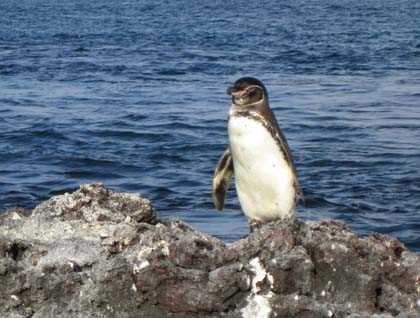Located in the center of the archipelago, Santiago or San Salvador was the island most visited by Charles Darwin in 1835 and nowadays it is the only island with highlands but no inhabitants. And it made for a fascinating stop in our continuing adventure.
Early in the morning the National Geographic Islander dropped anchor in front of Chinese Hat, which gets its name from its conical shape. Because the landscape has very little vegetation, it is easy to observe the remnants of the last volcanic eruptions and lava flows that occurred a long time ago.
After breakfast, we started our morning by exploring the shore from our Zodiacs. We visited the small channel that separates Chinese Hat from Santiago with the mission of locating some penguins. Success! We observed several penguins on the rocks and others swimming in a feeding frenzy trying to catch some mullets. Meanwhile, on the lava shores, marine iguanas, lava herons and crabs delighted our guests. We crossed to the shallows of Chinese Hat, where several great blue herons hunted for fish or crabs and some cute sea lions sunned themselves on the white beach, all of us observed by a Galapagos hawk perched on the rocks.
After our Zodiac ride, we came back to the channel to snorkel in its turquoise and transparent waters, where marine iguanas swam along the seashore. The temperature and visibility were great. Curious penguins swam close to us, while colorful fish, sea stars and sharks made our experience unforgettable. After snorkeling, the National Geographic Islander repositioned in front of one of the Bainbridge islets. Here, inside a caldera, is a brackish lagoon that is home to a number of flamingos that come here to feed on small shrimps and other crustaceans. We counted 25 flamingos, their pink bodies contrasting with the green vegetation along the shore and the brown lava along the walls inside the caldera.
In the afternoon we dropped anchor at Sullivan Bay, just in front of Bartolome Island. We came here to explore a large and impressive black lava field. Formed after a great eruption in 1897, it offers the best examples of how pioneer species begin to colonize new ecosystems. We walked along ropy lava that took on fascinating shapes against a colorful landscape of green highlands and brown hills. Along the path, white marks showed us where trees or animals had been trapped by molten lava. We observed small plants making their way through the hard lava rock, insects feeding on leaves, and small reptiles, such as lava lizards and snakes, acting as predators in this hostile environment.
The sunset illuminated the hills and the sky with a unique orange color. The ocean, which was choppy in the morning, was now calm. In the air, noisy seabirds flew back to their nests, telling us this beautiful day was over but leaving us with the best memories of this incredible day in the Galapagos Islands.







